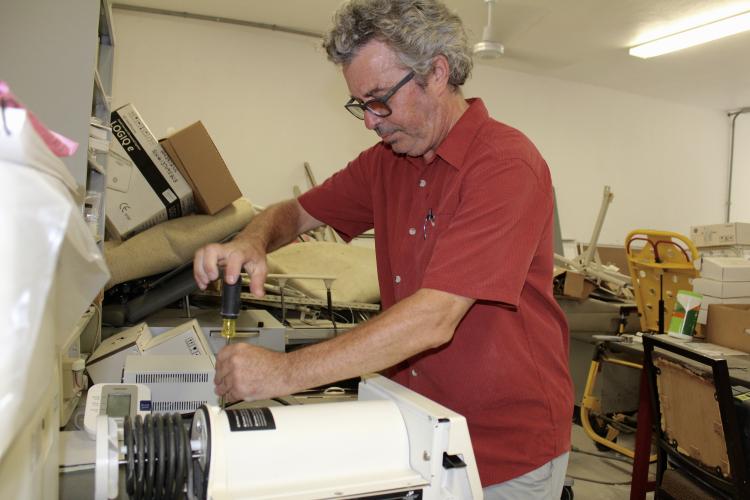“We value making patients feel welcome.”
Your donation will help Nurse Laguerre provide the highest-quality care to every patient in need.


Tom Monaghan has worked as the sole biomedical engineering technician at SBH for half a year, fixing lifesaving medical equipment to ensure hospital staff has the tools they need to provide high quality care to patients.
Tom, a Boston native, worked as Chief Biomedical Engineering Technician at Massachusetts General Hospital (MGH). In 2010, he traveled to Haiti with a team of (MGH) clinicians to assist with earthquake relief efforts. This trip would mark his first of many to the island nation. Tom began traveling back and forth from Boston to the Partners in Health sponsored hospital in Mirebalais, Haiti to repair and set up equipment.
Since joining the SBH team, Tom has become integral to the efficiency of the hospital. And perhaps no one knows this better than long-time SBH employee, Guito Poulard, who has worked for the hospital for nearly a decade as part of the maintenance and repairs team. Guito works closely with Tom and has personally experienced the technician’s significant contribution.
“With Tom here, we’ve made many improvements; his time here has been, and will continue to be, very helpful. When Tom was not here to fix equipment, it was my job, but I didn’t have much experience,” says Guito. “But that all changed when Tom got here. I’ve learned so much working alongside him.”
With Tom’s training, I’m able to use my equipment to its fullest potential, the way it was meant to be used.
Miss Pascale
Tom will be working with us in Fond des Blancs for two years, in which time he plans to not only improve our current biomedical equipment situation but also to build a sustainable biomed program at SBH. Tom will be selecting and training a small group of biomedical technicians who will continue his work of installing, maintaining, and repairing medical devices. This will enhance the long-term impact of his time at the hospital since he will leave a legacy of skilled local technicians who will continue to ensure that our patients and staff have access to all of the equipment the hospital has to offer.
In addition to training new biomedical technicians, Tom is also working closely with clinical staff to provide training on the use and care of medical equipment. “Training the staff here will be very helpful–especially the nurses,” Guito explains. “Sometimes the equipment will give error messages, and training our nurses to learn each unit’s language and how to troubleshoot will prevent many problems.”
Miss Rose Pascale Paul, Head Nurse of the Neonatal Intensive Care Unit, recognizes just how important it is to have someone like Tom on-site.
“The quicker we can fix the equipment, the quicker we can do our job and provide care to our patients,” she says. “There isn’t an abundance of equipment, so if one piece is not working, we may not have a replacement. There have been instances in the past when a premature baby came in and we did not have a working incubator. In that case, we felt like we had very few options.” Now, with Tom’s help, the NICU can avoid these life-or-death equipment situations and ensure that everything is functioning as it should.

Tom’s expertise has also made Miss Pascal and her team better equipped to deal with machines when they fail, as they inevitably do from time to time, partly due to the inconsistency of the electrical current from the hospital’s generators.
“I am now able to do my job better. I rest assured knowing that I not only have support when something goes wrong but also that I can fix some of the problems myself,” she explains. “With Tom’s training, I’m able to use my equipment to its fullest potential, the way it was meant to be used.”
HEI/SBF’s Chief Operating Officer, Bill Gimson, remembers a time before Tom joined the team, and the hospital encountered a problem with its only X-ray machine. Bill and another employee lugged the broken machine on a day-long journey by bus to Santo Domingo, in the Dominican Republic, where it was scheduled to be fixed.
When they finally arrived, Bill stayed in Santo Domingo for five days, waiting for the machine to be repaired. He returned to Fond des Blancs almost a week later, hauling the heavy piece of equipment behind him.
The X-ray machine stopped working again just a few days later.
“It was incredibly inconvenient. I had to take a week from work just to have one machine repaired,” Bill remembers. “And the entire excursion was in vain because it only worked for a day or two.”
Luckily, Tom came down a few weeks later and quickly diagnosed the problem. The machine was up and running within several hours. Almost a year later, Tom still has to make frequent tweaks to the machine—ones that without him, would have required long trips to Santo Domingo or Port-au-Prince, and a heavy investment in repair fees.
“He tackles every challenge we’ve thrown his way, and I can’t wait until we have a team of technicians repairing equipment with little turnover time,” says Bill.
SBH’s chief nurse, Miss Kenide Bien Aimé, can’t imagine not having Tom on-hand to help with the sensitive and complicated equipment that patients and staff depend on.
“He is a very good technician. He does a good job and is always there. He’s efficient, fast, and competent,” Miss Kenide explains. “Can Tom stay with us forever? We need him.”
Thankfully, when Tom does return to his regular job at MGH, he will leave behind a team of trained Haitian biomedical technicians who will take over this critically important role at SBH.
Your donation will help Nurse Laguerre provide the highest-quality care to every patient in need.
